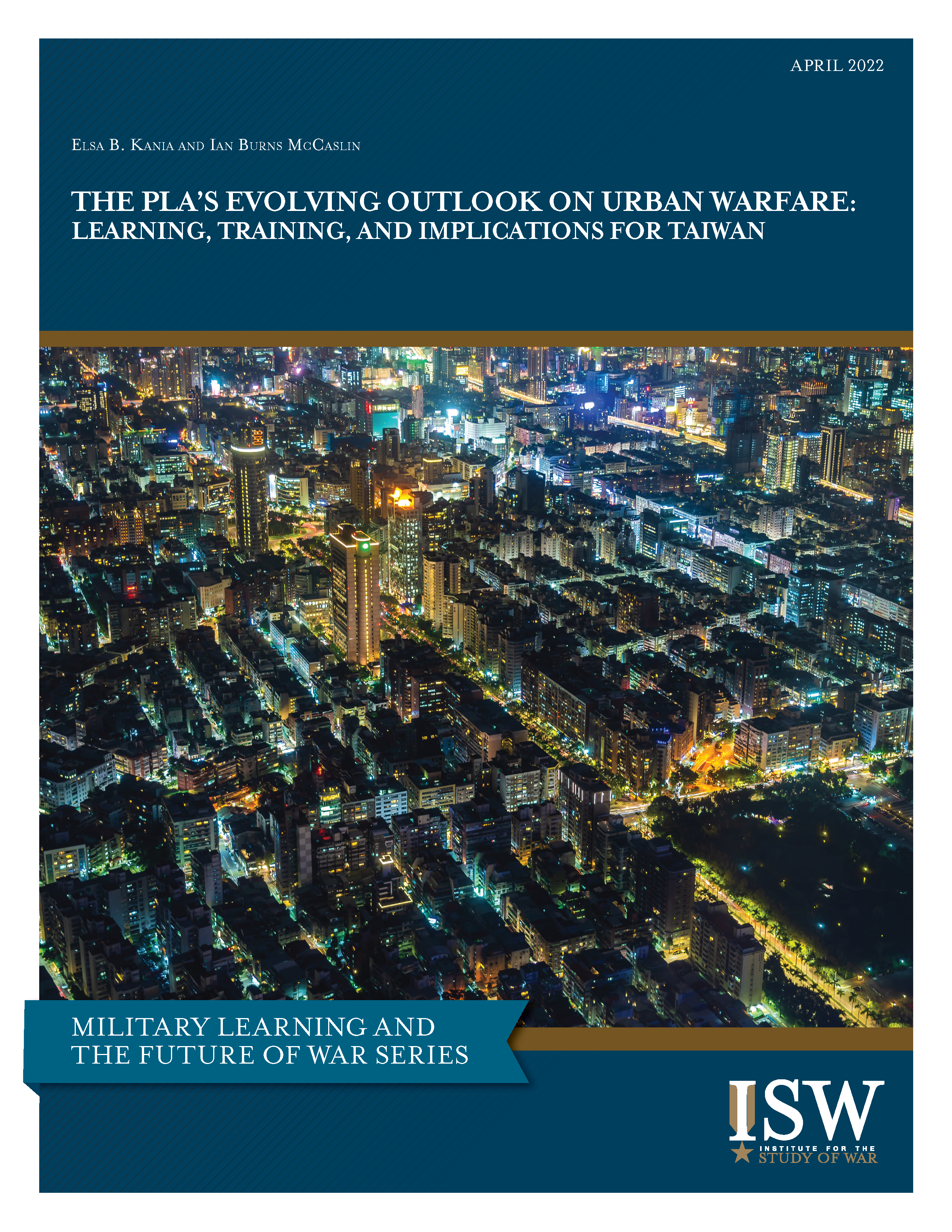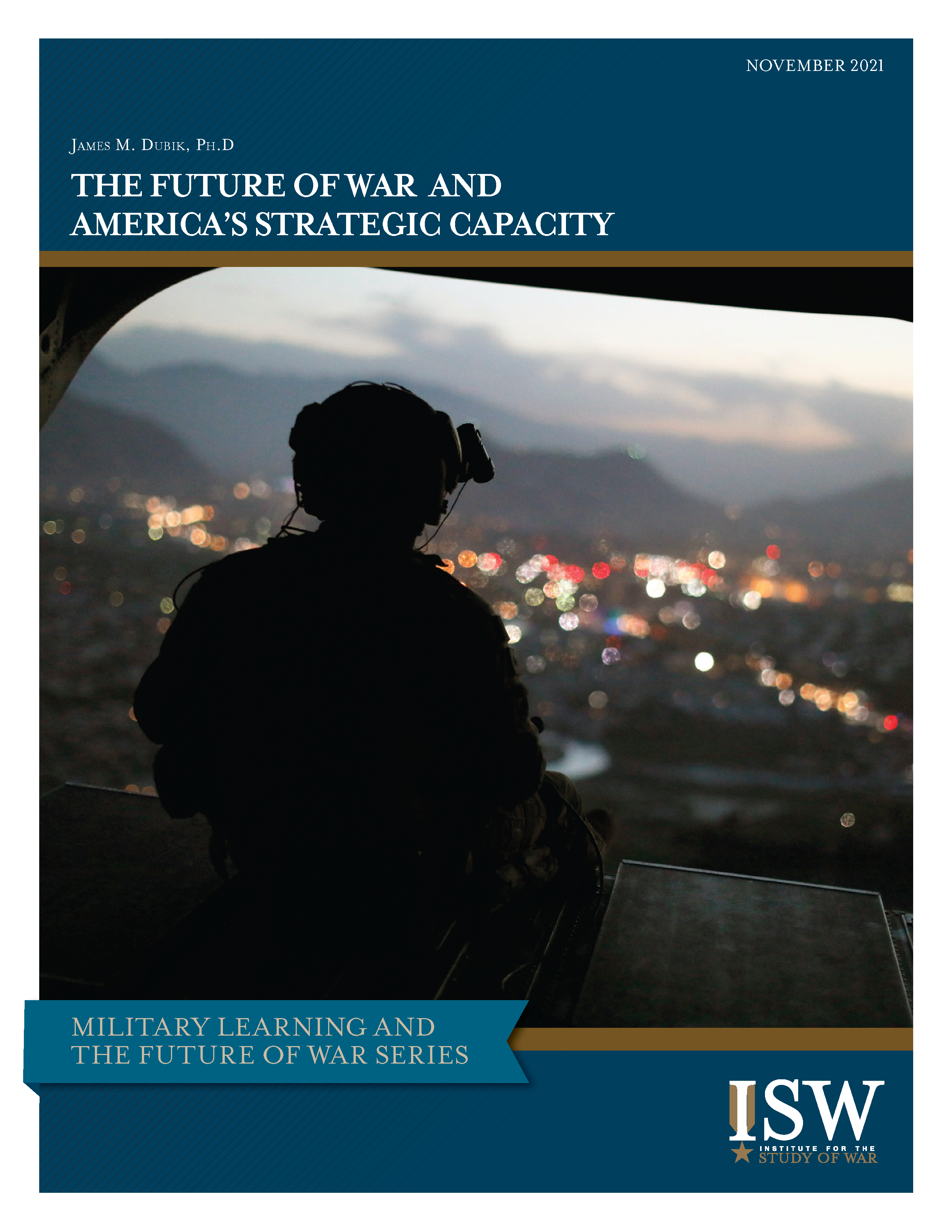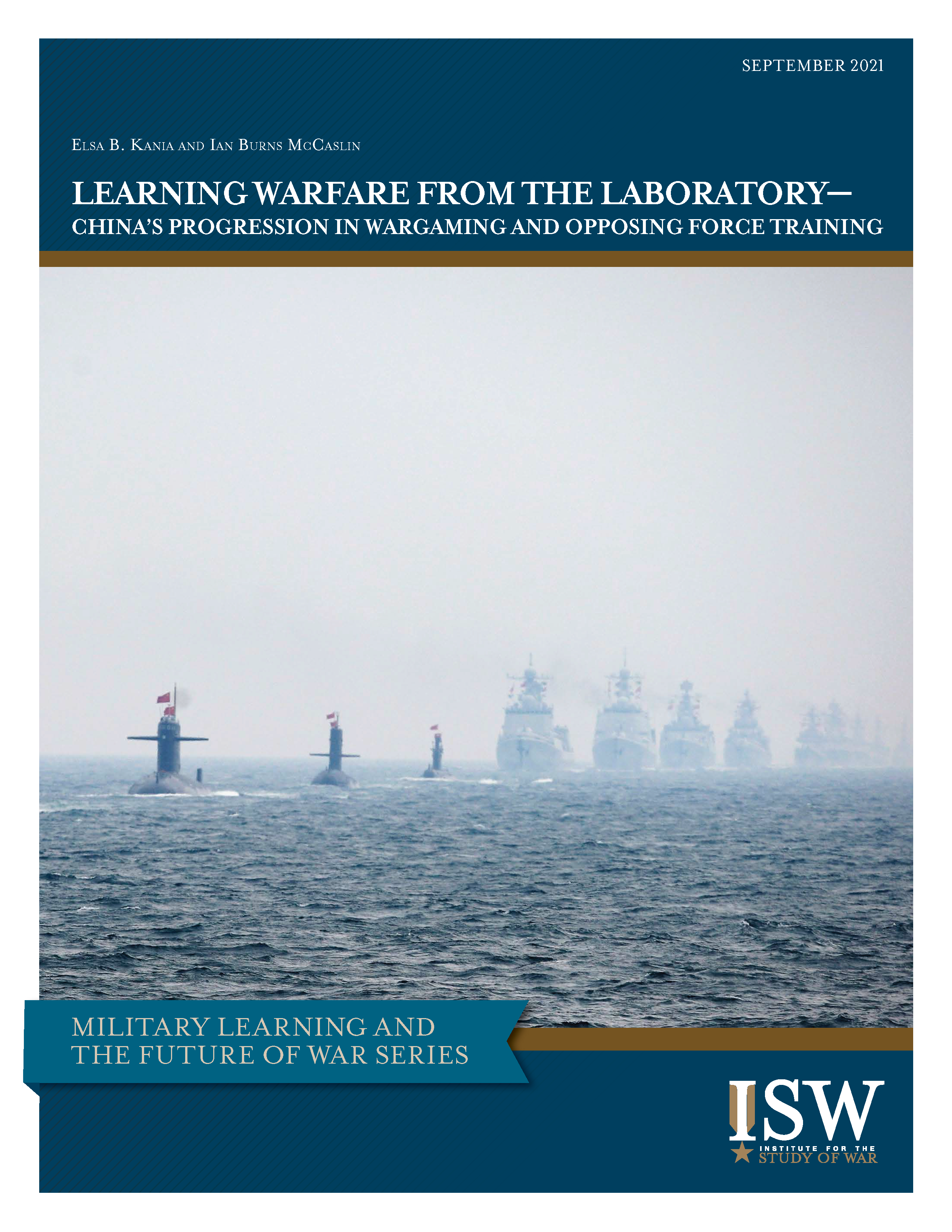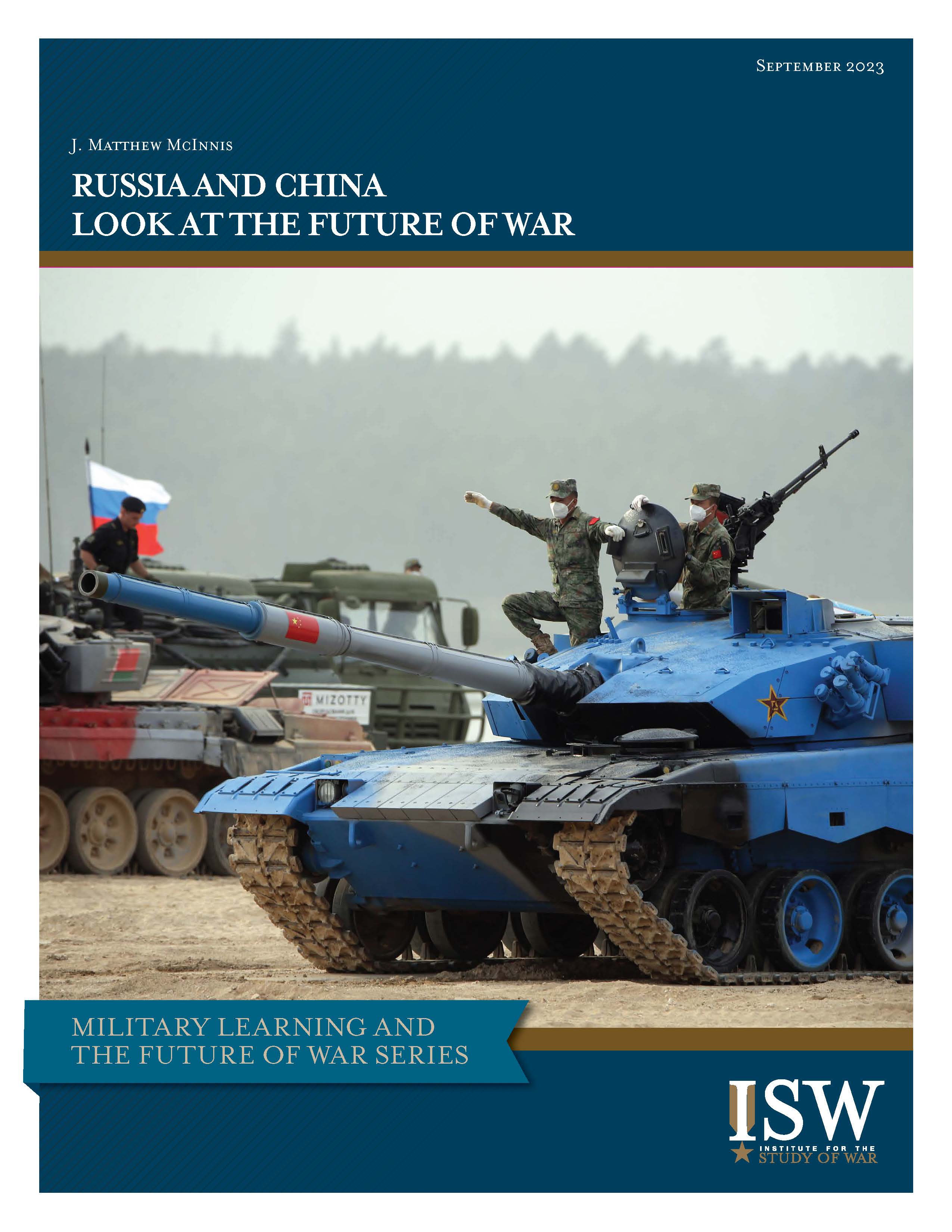 |
 |
Military Learning and the Future of War Project
Overview
This series of papers explores the ways the United States and its potential adversaries, including Russia and China, are learning from ongoing geopolitical competition and military engagements. The series explores the ways these evolutions in the operating environment provide opportunities for experimentation and testing of new technologies, capabilities, and approaches to war. The papers explore organizational adaptations to incorporate new capabilities, doctrinal changes to harness them, and the ability to institutionalize these changes in ways that will shape the future of war.
Papers:
- Russia and China Look at the Future of War, by Matthew McInnis (September 2023)
- The PLA's Evolving Outlook on Urban Warfare: Learning, Training, and Implications for Taiwan by Elsa Kania and Ian Burns McCaslin (April 2022)
- The Future of War and America’s Strategic Capacity by Gen. James Dubik (US Army, Retired) (November 2021)
- Learning Warfare from the Laboratory - China’s Progression in Wargaming and Opposing Force Training by Elsa Kania and Ian Burns McCaslin (September 2021)
- The Russian Military's Lessons Learned in Syria, Report by Mason Clark (January 2021)
- People's Warfare against COVID-19: Testing China's Military Medical and Defense Mobilization Capabilities, Report by Elsa Kania and Ian Burns McCaslin (December 2020)
- Military Learning and the Future of War, Essay by ISW President Kim Kagan (September 2020)
- Putin's Offset: The Kremlin's Geopolitical Adaptations since 2014, Report by Nataliya Bugayova (September 2020)
- Russian Hybrid Warfare, Report by Mason Clark (September 2020)
Russia and China Look at the Future of War
Report by Matthew McInnis (September 2023)
Russia and China share a common modernization objective: achieving dominance in decision-making in future wars. Both states are struggling to improve their military personnel quality and integrate the lessons from the wars of the past two decades. Russia is attempting to innovate within a narrower band of military doctrine and operations while addressing the early failures of its Ukraine invasion. China aims to use new doctrine, technology, and integration of civilian expertise with the People Liberation Army (PLA) to leapfrog over US military superiority. The United States must assess the threat from China’s and Russia’s modernization efforts and seek to exploit their respective blind spots and weaknesses.
Read the executive summary and download the full report here.
The PLA’s Evolving Outlook on Urban Warfare: Learning, Training, and Implications for Taiwan

The Future of War and America’s Strategic Capacity
Report by Gen. James Dubik. US Army, Retired. (November 2021)
Read the executive summary and download the full report here.

Learning Warfare from the Laboratory - China’s Progression in Wargaming and Opposing Force Training
Report by Elsa Kania and Ian Burns McCaslin (September 2021)
Read the executive summary and download the full report here.

The Russian Military's Lessons Learned in Syria
Report by Mason Clark (January 2021)
Read the executive summary and download the full report here.
People's Warfare against COVID-19: Testing China's Military Medical and Defense Mobilization Capabilities
Report by Elsa Kania and Ian Burns McCaslin (December 2020)
The COVID-19 pandemic is changing the global order and reshaping the balance of power on the world stage. The lessons that nations and their militaries take from this crisis will shape their capacity to adapt to COVID-19 and enhance their resilience to future crises. This paper explores the initial lessons the Chinese Communist Party (CCP) and the People’s Liberation Army (PLA) are learning from the COVID-19 pandemic and what those lessons could teach the PLA about mobilizing in response to future crises, including with the United States.
China tested its evolving nationwide defense mobilization to wage “people’s warfare” against the pandemic by leveraging all available resources and capabilities, including military, reserve, and militia forces. The PLA’s approach to COVID-19 leveraged previous experiences with pandemics and tested China’s strategy of civil-military fusion by combining military and civilian resources.
The CCP considers its national response to the coronavirus pandemic to be not only successful but also superior to that of the US, boosting Chinese confidence in the PLA as China’s rivalry with the US and its allies in the Indo-Pacific accelerates into an aggressive competition. The implications of the PLA’s active learning from its “people’s war” against COVID-19 are extensive and demonstrate the growing military capabilities of China as it seeks to actively contest the US-led international order, both in Asia and farther afield.
These lessons learned by the PLA during the COVID-19 crisis may eventually inform China’s transition from peacetime preparedness to a wartime footing in future conflict scenarios, including against the US and its allies.
Read the executive summary and download the full report here.
Military Learning and the Future of War
Read this essay from ISW's President and Founder Kimberly Kagan to learn more about the project. (September 2020)
Putin's Offset: The Kremlin's Geopolitical Adaptations since 2014
Report by Nataliya Bugayova (September 2020)
The West has had some success in countering the Kremlin since Russia’s illegal occupation of Crimea, but Russian President Vladimir Putin has found ways to offset external pressures on Russia without relinquishing his gains and goals. Putin’s center of gravity is increasingly his ability to shape others’ perceptions and create the image of a powerful Russia based on limited real power.
Putin’s efforts since 2014 to offset the weaknesses of Russia’s position and advance his goals have focused on creating a Russia-favorable global information space; growing Russia’s military footprint in a targeted way that provides asymmetric opportunities to influence decision making; cocooning Russia in a network of coalitions and international organizations to amplify Russia’s limited power; diversifying the tools and means of Russia’s influence and subversion; expanding Russia’s influence in peripheral theaters; and consolidating power inside Russia.
Putin’s evolving approaches enable him to play a bad hand well, but his hand remains weak. Putin’s dependency on asymmetrical approaches will grow as the gap between his means and aims likely increases. This gap will not necessarily threaten the survival of Putin’s regime, but it will provide opportunities for the US to counter the Russian challenge.
The West should cut oxygen to two key amplifiers of Putin’s power — narratives and coalitions. The long-term solution versus Russia would be building collective immunity to the Russian challenge, including strategic intelligence capabilities in the US and its partners to recognize Putin’s slow tactical creep before it becomes his strategic advantage.
Read the executive summary and download the full report here.
Russian Hybrid Warfare
Report by Mason Clark (September 2020)
America’s current strategy for responding to the Russian threat is based on a misunderstanding of the Russian approach to war and exposes the United States and its allies to a high risk of strategic defeats. The 2018 US National Defense Strategy gives primacy to deterring major conventional great power wars. Russia also seeks to avoid such wars even as it designs a different way of waging war to achieve its revisionist objectives. The US largely views this Russian approach, hybrid war, as a set of activities below the level of conventional conflict. But Russia includes significant conventional conflict in its conception and execution of hybrid war. If the US continues to focus on deterring the kind of war Russia does not intend to fight while underestimating the role military force can and must play in preventing Moscow from accomplishing its aims through hybrid war, then the US will likely suffer serious strategic defeats even as its defense strategy technically succeeds.
The Kremlin is even now waging a hybrid war against the United States. The Kremlin assesses that hybrid wars already dominate 21st century conflict and will continue to do so. The Kremlin believes it must adapt to win this struggle, profoundly shaping Russian military development and assessments of the future of war.
Russian hybrid wars include the use of significant conventional forces and conflict. The Russian military defines a “hybrid war” as a strategic-level effort to shape the governance and geostrategic orientation of a target state in which all actions, up to and including the use of conventional military forces in regional conflicts, are subordinate to an information campaign.
The Russians define hybrid war precisely and coherently as a type of war, rather than a set of means to conduct state policy. The U.S discussion of hybrid war overly focuses on the means short of conventional forces and conflict that the Russians have most famously used. The Russian soldiers without insignia (“little green men”) who helped seize Crimea in 2014, and the proxies Russia uses in eastern Ukraine, are most often the focus of Western assessments about how to respond to Russian hybrid war.
The Russian conception of hybrid war is much more expansive. It covers the entire “competition space,” including subversive, economic, information, and diplomatic means, as well as the use of military forces extending above the upper threshold of the “gray zone” concept that more accurately captures the Chinese approach to war.
Read the executive summary and download the full report here.
